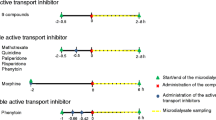Abstract
In a displacement test using3H-diazepam as a radioligand, the in vitro affinities of metabolites of camazepam (CZ) for the benzodiazepine receptors were 1–50 times more potent than that of CZ. In contrast, only three metabolites (temazepam, oxazepam, and hydroxy CZ), as well as CZ itself, exhibited an in vivo affinity parallel to their ability to protect against pentylenetetrazole-induced clonic convulsion in rats. In addition, CZ and these active metabolites displaced the radioligand from their receptor sites in a concentration-dependent saturable manner, indicating the competitive bimolecular interaction of these molecules with their receptors. The percent anticonvulsant effect was a nonlinear, single-valued function of the in vivo percent displacement of specific3H-diazepam binding, independent of these displacers after i.v. dosing; this relationship could be approximated by the Hill equation. On the basis of these findings, a receptor-mediated model, including the Langmuir equation to describe the receptor binding-brain concentration relationship and the Hill equation to accommodate the anticonvulsant effect-receptor binding relationship, was constructed. This model was found to adequately relate the time course values of anticonvulsant effect and of brain levels of CZ and its active metabolites after oral administration. These results demonstrate that CZ and its active metabolites exert anticonvulsant effect by competitive binding to the benzodiazepine receptors.
Similar content being viewed by others
References
S. H. Curry and R. Whelpton. Pharmacokinetics of closely related benzodiazepines.Br. J. Clin. Pharmacol. 8:15s-21s (1979).
S. Garattini, E. Mussini, F. Marcucci, and A. Guaitani. In S. Garattini, E. Mussini, and L. O. Randall (eds.),The Benzodiazepines, Raven Press, New York, 1973, pp. 75–97.
A. Morino, A. Nakamura, K. Nakanishi, N. Tatewaki, and M. Sugiyama. Species differences in the disposition and metabolism of camazepam.Xenobiotica 15:1033–1043 (1985).
A. Morino and M. Sugiyama. Relation between time courses of pharmacological effects and of plasma levels of camazepam and its active metabolites in rats.J. Pharmacobio-Dyn. 8:597–606 (1985).
T. Shibuya, R. Field, Y. Watanabe, K. Sato, and B. Salafsky. Structure-affinity relationship between several new benzodiazepine derivatives and3H-diazepam receptor sites.Jpn. J. Pharmacol. 34:435–440 (1984).
R. S. L. Chang and S. H. Snyder. Benzodiazepine receptors: Labeling in intact animals with3H-flunitrazepam.Eur. J. Pharmacol. 48:213–218 (1978).
D. Mackay. In J. M. van Rossum (ed.),Kinetics of Drug Action, Springer, New York, 1977, pp. 255–321.
M. Berman, S. Shahn, and M. F. Weiss. The routine fitting of kinetic data to models: A mathematical formalism for digital computers.Biophys. J. 2:275–287 (1962).
M. Nielsen, C. Braestrup, and R. F. Squires. Evidence for a late evolutionary appearance of brain specific benzodiazepine receptors: An investigation of 18 vertebrate and 5 invertebrate species.Brain Res. 141:342–346 (1978).
C. Braestrup and R. F. Squires. Pharmacological characterization of benzodiazepine receptors in the brain.Eur. J. Pharmcol. 48:263–270 (1978).
A. S. Lippa, L. R. Meyerson, and B. Beer. Molecular substrates of anxiety: Clues from the heterogeneity of benzodiazepine receptors.Life Sci. 31:1409–1417 (1982).
T. Mennini, S. Cotecchia, S. Caccia, and S. Garattini. Benzodiazepines: Relationship between pharmacological activity in the rat andin vivo receptor binding.Pharmacol. Biochem. Behav. 16:529–532 (1982).
S. M. Paul, P. J. Syapin, B. A. Paugh, V. Moncada, and P. Skolnick. Correlation between benzodiazepine receptor occupation and anticonvulsant effects of diazepam.Nature 281:688–689 (1979).
Y. Igari, Y. Sugiyama, Y. Sawada, T. Iga, and M. Hanano. Kinetics of receptor occupation and anticonvulsive effects of diazepam in rats.Drug Metab. Dispos. 13:102–106 (1985).
W. D. Paton and D. R. Waud. The margin of safety of neuromuscular transmission.J. Physiol. 191:59–90 (1967).
S. Caccia, G. Guiso, R. Samanin, and S. Garattini. Species differences in clobazam metabolism and antileptazol effect.J. Pharm. Pharmacol. 32:101–103 (1980).
S. Ichimaru, Y. Kudo, Y. Kawakita, and O. Shimada. Phase 1 study of KTH-497, a new benzodiazepine derivative.Clin. Eval. 12:15–41 (1984).
S. Caccia, M. Ballabio, and S. Garattini. Relationship between camazepam,N-methyl-oxazepam and oxazepam brain concentrations and antileptazol effect in the rat.J. Pharm. Pharmacol. 33:185–187 (1980).
A. d'Hollander and C. Delcroix. An analytical pharmacodynamic model for nondepolarizing neuromuscular blocking agents.J. Pharmacokin. Biopharm. 9:27–40 (1981).
Author information
Authors and Affiliations
Rights and permissions
About this article
Cite this article
Morino, A., Sasaki, H., Mukai, H. et al. Receptor-mediated model relating anticonvulsant effect to brain levels of camazepam in the presence of its active metabolites. Journal of Pharmacokinetics and Biopharmaceutics 14, 309–321 (1986). https://doi.org/10.1007/BF01106709
Received:
Revised:
Published:
Issue Date:
DOI: https://doi.org/10.1007/BF01106709




